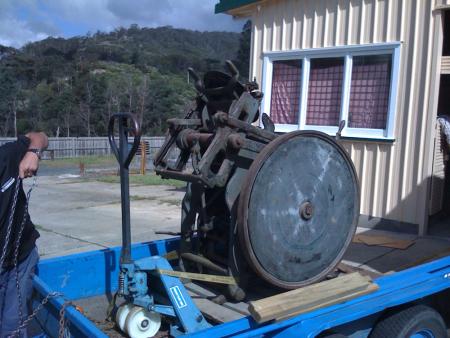Tips for beginning restoration
Hi All!
Long time no post! As we head into Christmas and the festive season I have a bit of time to start work on restoring one of my eBay purchases (a C&P 10x15”).
I’m just after some general advice regarding equipment (or even just a pointer towards another page on here which goes into more detail on cleaning and restoring an older press) to use when cleaning it up.
The attached images give a rough idea of general condition, there’s a bit of surface rust but everything seems to be moving okay (if a little stiffly - it hadn’t been used for years before I picked it up).
The place I have it in storage is some distance away from my home and easy access to tools so any suggestions of what kit might be a good idea for a few solid days cleaning and tidying up would be most appreciated. I’ve been printing for the last year or so on other people’s gear and now I’m looking to get my gear in order.
Thanks in advance!

chandler_price_pickup_1.jpg

chandler_price_pickup_2.jpg
This has been covered a lot on Briar Press already, so definitely check the archives here.
With restoration, there’s a balance to be found between the amount of time you’re willing to spend toiling away on your press, and the quality of the restoration.
For a full restoration, you’re looking at a shell blasting and repainting with possible disassembly and pin-striping. For “just enough to get in working order” you’re looking at removing the rust with elbow grease and running a light-weight oil through the joints for several months until you flush everything out.
Clean a bit, discover something. Order a part, then clean again. It keeps on going in a cycle. Know that you’ll never be able to have everything that you need to have a perfect press, but then again, a good printer produces excellent results independent of equipment.
Good luck,
James Beard
Vrooooom Press
www.vrooooom.org
Thanks James,
I must be phrasing my search incorrectly, I will dig deeper! I knew there has to be stuff on here already about this topic, but my quick search was turning up a lot of irrelevant stuff.
Yep at this stage it’s repair and stopping any damage and rust and in long term I’m planning to completely rebuild, but that’s further down the road.
Cheers :)
If you plan to remove some of the rust and gunk from the body/frame of the press I’d recommend a good drill/driver with a wire wheel attachment. That generally will make short work of any built up rust. Don’t use it on the ink disc, platen, or chase bed, though as you don’t want any nicks or dings. I’ve used steel wool and superfine sandpaper on those parts with great success.
Recently I saved an otherwise junked ink disc with 200 grit sandpaper on a random orbital sander. Just work carefully and take your time.
You might consider painting some of the pieces you are cleaning (anything that was painted before might need a new coat to inhibit rust). I’d recommend an oil-based industrial enamel. There should be a few to choose from at most home improvement stores. Brush it on taking care to avoid any oil holes or other points where dried paint could cause a problem.
Finally, get a respirator, coveralls, and some good gloves. I’m not sure what kind of paint was used to paint these presses originally, but if it’s being sanded and scraped you don’t want to be breathing it in.
Hope this helps,
Brad.
Hi Brad,
Thanks for your advice - I didn’t even think about a respirator – I have a good one, I just didn’t think about the kind of paint this thing would have been originally been painted with!
This is all stuff that probably would have occurred to me *after* I’d started, so thanks again!
Speaking only for myself, I think that sandblasting, priming, painting and pin-striping is a waste of time if you are going to use the press and not use it for display. In most cases, a rubdown with steel wool dipped in kerosene will remove loose rust and give the iron a slightly oily protective coating. As for lubricating the joints, use a drill bit, and twist it by hand, to remove the gunk, put some kerosene in the holes, and cycle the press. Repeat the kerosene treatment a few times to flush out the joints, then oil everything. Run the press and oil it again. Repeat. It won’t take months to get everything moving smoothly again. I had a press that sat outdoors in the rain for several years, and was able to get it working again in one weekend.